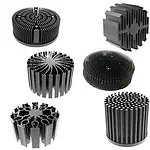Have you ever found yourself in a situation where the power suddenly goes out, leaving you in complete darkness? Or you’ve been in a large building when the fire alarm goes off, and you’re unsure where the nearest exit is. These scenarios can be disorienting and potentially dangerous, which is where emergency lighting comes into play.
Emergency lighting is a crucial aspect of any building’s safety measures. It provides illumination when the regular power supply fails, ensuring that occupants can safely exit the building. It also highlights fire equipment and exit routes, reducing panic and confusion in emergencies.
So, let’s delve deeper into emergency lighting and why it’s so important.
What Are The Different Types Of Emergency Lighting?
Emergency lighting is not a one-size-fits-all solution. There are several types, each designed to meet specific needs and requirements.
Maintained Emergency Lighting stays on at all times, functioning as regular and emergency lighting. This type is common in theatres, cinemas, and other places where sudden darkness could cause panic.
On the other hand, Non-Maintained Emergency Lighting only activates when the main power supply fails. It’s typically used in workplaces and other buildings where occupants know the layout.
Sustained Emergency Lighting combines the two, with one set of lights for regular use and another for emergencies.
Self-Contained Emergency Lighting has all components within the light fitting, including the battery and control unit. This type is easy to install and maintain, making it a popular choice for many buildings.
Central Battery Source Emergency Lighting uses a central battery to power all emergency lights in a building. While more complex to install, it offers benefits like easier maintenance and longer battery life.
Standby Lighting is another type of emergency lighting that provides illumination for normal activities to continue during a power outage. However, it’s not a substitute for escape lighting.
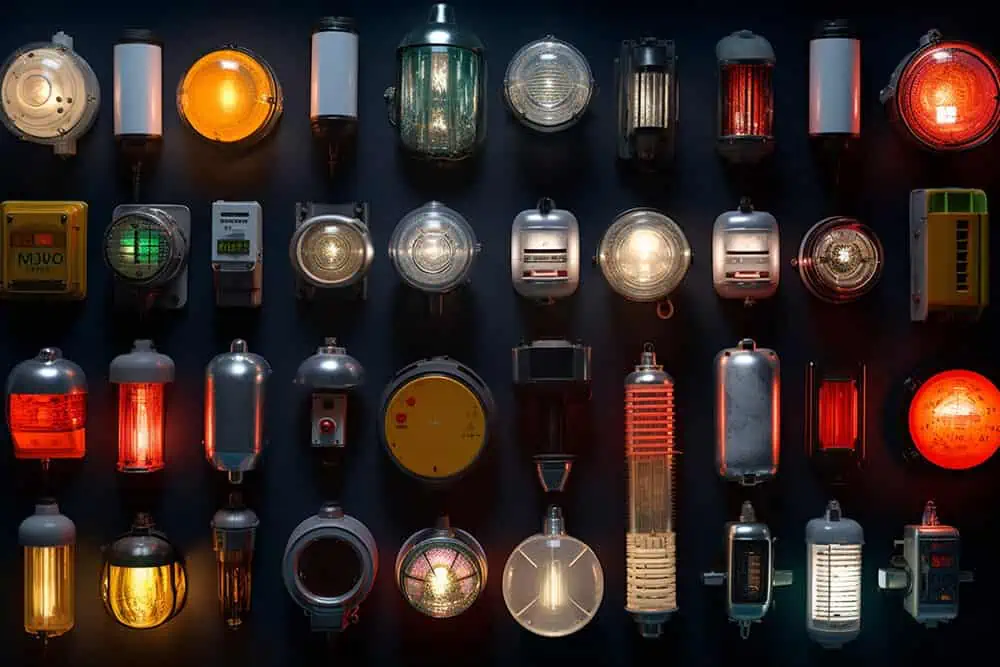
What Are The Subcategories Of Emergency Lighting?
Emergency lighting can be divided into subcategories based on purpose and location.
Emergency Escape Lighting provides illumination for the safety of people leaving a location or attempting to terminate a potentially dangerous process. It’s part of the fire safety provision of a building.
Standby Lighting allows normal activities to continue during a power failure. However, it’s not considered emergency lighting under some regulations.
Escape Route Lighting ensures that escape routes are well-lit, so people can safely and swiftly exit a building.
Open Area Lighting, also known as anti-panic lighting, minimizes panic when people gather, aiding in orderly evacuation.
High-Risk Task Area Lighting provides illumination for safety-critical tasks that must be finished before evacuation, ensuring the safety of the person involved.
What Are The Components Of Emergency Lighting?
Like any other system, emergency lighting comprises several vital components.
The Light Source is the most visible part of the system. It can be any lamp or LED that provides sufficient illumination.
The Power Supply provides energy to the light source. In the case of emergency lighting, this is typically a secondary power source separate from the main building power.
The Battery in an emergency lighting system plays a crucial role. It stores energy when the main power supply is functioning and then provides this stored energy to the light source when the main power fails. This ensures the emergency lights work during a power outage, providing essential illumination for safe evacuation.
The Control Unit manages the operation of the emergency lighting system. It monitors the main power supply and switches to the battery power when it detects a failure.
What Standards And Regulations Govern Emergency Lighting?
Emergency lighting is subject to various standards and regulations to ensure its effectiveness and reliability.
BS 5266-1 is a British Standard that provides guidelines for the design, installation, and wiring of emergency lighting systems. It covers areas like luminaire performance, testing procedures, and documentation.
The Regulatory Reform (Fire Safety) Order 2005 is a UK law that requires building owners to ensure the safety of occupants in case of fire. This includes providing adequate emergency lighting.
There are also other relevant standards, both national and international, that may apply depending on the location and type of building.
How Is Emergency Lighting Designed And Installed?
The design and installation of emergency lighting require careful planning and consideration.
Design Considerations include the type and duration of lighting, the size and usage of the building, and the presence of any specific hazards. The goal is to ensure that all escape routes and safety equipment are adequately illuminated in an emergency.
The Installation Process involves placing the lights in appropriate locations, wiring them to the power supply, and setting up the control unit. A qualified electrician should carry out all work to ensure safety and compliance with regulations.
Locating Your Emergency Lights is a crucial part of the installation process. Lights should be placed near exits and fire equipment, along escape routes, and in large open areas. They should also be positioned to minimize shadows and glare.
Why Is Planning Important In Emergency Lighting?
Planning is a critical step in ensuring the effectiveness of an emergency lighting system.
The Importance of Planning cannot be overstated. A well-planned system will provide adequate illumination in all critical areas, guiding occupants safely to exits during an emergency.
Planning Your Emergency Lighting Installation includes assessing the building’s needs, designing the system, selecting the appropriate lights, and planning their placement. Regular testing and maintenance should also be part of the plan.
How Is Emergency Lighting Tested?
Regular testing is essential to ensure emergency lighting functions correctly when needed.
The Importance of Regular Testing lies in emergency lighting being a safety-critical system. Any failure could put lives at risk during an emergency.
Testing Procedures typically involve simulating a power failure to check that the lights activate and provide sufficient illumination. The battery’s performance and the operation of the control unit should also be checked.
Maintaining Compliance with regulations is another reason to conduct regular testing. Documentation of tests can provide evidence of compliance in case of an inspection or audit.
What Are The Viewing Distances For Exit Signs?
Exit signs are crucial to any emergency lighting system, guiding occupants to the nearest exits in an emergency. However, they must be visible and legible from a distance to be effective.
According to the Occupational Safety and Health Administration (OSHA), each exit sign must be illuminated to a surface value of at least five-foot candles (54 lux) by a reliable light source and be distinctive in color. Self-luminous or electroluminescent signs with a minimum luminance surface value of at least .06 foot-lamberts (0.21 cd/m2) are permitted.
Each exit sign must have the word “Exit” in plainly legible letters not less than six inches (15.2 cm) high, with the principal strokes of the letters in the word “Exit” not less than three-fourths of an inch (1.9 cm) wide.
If the direction of travel to the exit or exit discharge is not immediately apparent, signs must be posted along the exit access indicating the direction of travel to the nearest exit and exit discharge. Additionally, the line-of-sight to an exit sign must always be visible.
What Are The Power Supply Options For Emergency Lighting?
Emergency lighting systems can be powered in different ways, each with its own advantages and disadvantages.
Self-Contained Systems have all components, including the battery, within the light fitting. This makes them easy to install and maintain, but they may need to be more suitable for more significant buildings due to individual testing and maintenance of each light.
Central Battery Source Systems use a central battery to power all emergency lights in a building. This can simplify testing and maintenance, as the battery and control unit are in one location. However, these systems are more complex to install and may be more expensive upfront.
What Is The Mode Of Operation For Emergency Lighting?
The mode of operation refers to how an emergency light functions in the main power supply.
Maintained emergency lights always stay on, functioning as regular and emergency lighting. They’re typically used in places where sudden darkness could cause panic.
Non-Maintained emergency lights only activate when the main power supply fails. They’re commonly used in workplaces where occupants are familiar with the layout.
Combined Emergency Luminaires are maintained emergency light that includes two or more lamps. One lamp operates on the main power supply, while the other(s) operate on the emergency power supply.
What Are The Different Emergency Lighting Facilities?
Emergency lighting facilities refer to the different features and capabilities of emergency lights.
A Luminaire Including Test Device has a built-in feature that allows it to be tested without additional equipment. This can simplify maintenance and ensure that the light is functioning correctly.
A Luminaire, Including Remote Test Device, can be tested remotely, which can be helpful for more significant buildings with many lights.
A Luminaire with Inhibiting Mode can be temporarily disabled to prevent it from activating during short power interruptions or maintenance work.
A High-Risk Task Luminaire provides illumination for safety-critical tasks that must be finished before evacuation, ensuring the safety of the person involved.
What Is The Duration Of Emergency Lighting?
The duration of emergency lighting refers to how long the lights can stay on in the event of a power failure. This is determined by the battery’s capacity and the lights’ power consumption.
The Importance of Duration is evident: the lights must stay on long enough for all occupants to exit the building safely. In some cases, they may also need to stay on longer to allow for safety-critical tasks to be completed.
Standards for Duration vary depending on the type of building and its usage. However, a common requirement is for the lights to be able to operate for at least three hours after a power failure.
How Are Emergency Lighting Systems Classified?
Emergency lighting systems are classified based on their mode of operation, duration, and other features. A code on the light fitting usually indicates this classification.
Understanding the Classification Code can help you choose the right lights for your needs and ensure compliance with regulations.
Classification Codes include “M3” for a maintained light with a three-hour duration and “NM3” for a non-maintained light with a three-hour duration.
Where Should Luminaires And Emergency Signs Be Located?
The location of luminaires and emergency signs is crucial for the effectiveness of an emergency lighting system.
The Importance of Proper sitting cannot be overstated. Lights and signs must be placed where they can be easily seen and provide adequate illumination.
Guidelines for Siting include placing lights near exits and along escape routes, above fire equipment, and in large open areas. Signs should be positioned to be seen from all directions and not obscured by any obstacles.
How Much Light Is Needed From An Emergency Lighting System?
The amount of light needed from an emergency lighting system depends on several factors, including the size and layout of the building, the nature of its usage, and the specific requirements of any applicable regulations.
Standards for Illumination typically specify a minimum illumination level for different areas, such as escape routes and safety equipment. These standards ensure that occupants can safely navigate the building in an emergency.
Factors Affecting Required Illumination include the size and complexity of the escape routes, the presence of any hazards, and the expected number of occupants.
What Is The Importance Of A Commissioning Certificate And Logbook For Emergency Lighting?
A commissioning certificate and logbook are essential documents for any emergency lighting system.
The Importance of Documentation lies in its role in demonstrating compliance with regulations and in facilitating maintenance and testing.
What Should Be Included in the Documentation includes details of the system design and installation, results of initial and periodic tests, and records of any maintenance or repairs carried out.
How Is Emergency Lighting Maintained?
Emergency lighting maintenance is a critical aspect of building safety. Regular maintenance ensures the system is reliable and effective, ready to operate in an emergency.
Regular maintenance is essential: a system that is not maintained correctly may fail to operate in an emergency, putting lives at risk.
Maintenance procedures for emergency lighting systems typically include:
Regular Testing: This involves simulating a power failure to ensure the lights activate as expected and provide sufficient illumination. The battery’s performance should also be checked to ensure it can power the lights for the required duration.
Cleaning of Light Fittings: Over time, dust and dirt can accumulate on light fittings, potentially reducing their brightness. Regular cleaning helps to ensure the lights provide the maximum possible illumination.
Replacement of Faulty Components: Any components that are found to be faulty or nearing the end of their service life should be replaced promptly to prevent failures. This includes the light source (e.g., lamp or LED), battery, and any parts of the control unit.
Record Keeping: All maintenance work should be carried out by a qualified person and recorded in the system logbook. This helps to ensure accountability and provides a record of the system’s maintenance history.
In addition to these procedures, it’s also important to regularly review the system’s design and configuration, especially if there are changes to the building’s usage or layout. This ensures the system provides adequate coverage and meets the building’s needs.
What Does Servicing And Testing Of Emergency Lighting Involve?
Servicing and testing are critical aspects of maintaining an emergency lighting system.
The Importance of Regular Servicing and Testing ensures the system will operate correctly in an emergency. Regular servicing can also extend the system’s life and reduce the risk of unexpected failures.
Servicing and Testing Procedures typically involve checking the operation of the lights and control unit, testing the battery, and inspecting the light fittings and wiring. Any faults should be repaired or components replaced as necessary.
FAQs
Emergency lighting provides illumination when the regular power supply fails, ensuring occupants can safely exit the building.
Types of emergency lighting include maintained non-maintained, sustained, self-contained, central battery source, and standby lighting.
An emergency lighting system typically includes a light source, power supply, battery, and control unit.
Emergency lighting is subject to various standards and regulations, including BS 5266-1 and The Regulatory Reform (Fire Safety) Order 2005.
Installation involves placing the lights in appropriate locations, wiring them to the power supply, and setting up the control unit.
Regular testing ensures that the lights will function correctly in an emergency and can provide evidence of compliance with regulations.
The duration refers to how long the lights can stay on during a power failure. A common requirement is for the lights to operate for at least three hours.
Systems are classified based on their mode of operation, duration, and other features. A code on the light fitting usually indicates this classification.
Lights and signs should be placed near exits, along escape routes, above fire equipment, and in large open areas. They should also be positioned to minimize shadows and glare.
The amount of light needed depends on several factors, including the size and layout of the building, the nature of its usage, and the specific requirements of any applicable regulations.
A commissioning certificate and logbook provide evidence of regulatory compliance and facilitate maintenance and testing.
Regular maintenance, including testing, cleaning, and replacing faulty components, ensures the reliability and effectiveness of the system.
Servicing and testing typically involve checking the operation of the lights and control unit, testing the battery, and inspecting the light fittings and wiring.
Conclusion
Emergency lighting is a crucial safety element within any building, providing essential illumination during power outages or emergencies. Its purpose is to ensure clear visibility of escape routes and safe evacuation of occupants. The system requires thoughtful design, correct installation, regular testing, and adherence to specific regulations. As technology progresses, we anticipate more effective, reliable solutions in emergency lighting.



